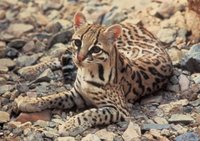Ocelots
|
|
| Ocelot Conservation status: Endangered | ||||||||||||||
|---|---|---|---|---|---|---|---|---|---|---|---|---|---|---|
 | ||||||||||||||
| Scientific classification | ||||||||||||||
| ||||||||||||||
| Binomial name | ||||||||||||||
| Leopardus pardalis (Linnaeus, 1758) |
The ocelot (Leopardus pardalis, or Felis pardalis) is a wild cat distributed over South and Central America. Its northernmost occurrence is Texas. It is up to 100 cm (3'2") in length, plus 45 cm (1'6") tail length. It is similar in appearance to the oncilla and the margay, who inhabit the same region, but the ocelot is larger. The name of the animal derives from Nᨵatl ocelotl (IPA /ɔ.θɛ.ɬɔtɬ/).
The ocelot is very nocturnal and territorial. Like most felines, they are solitary, usually meeting only to mate. However, during the day they rest in trees or other dense foliage, and will occasionally share their spot with another ocelot of the same gender.
While they are well equipped to an arboreal lifestyle, and will sometimes take to the trees, they are mostly terrestrial. Its prey includes monkeys, snakes, rodents and birds. Almost all of the prey that the ocelot hunts is far smaller than it is. Studies suggest that they follow and find prey via odor trails, but ocelots also have very keen vision.
The ocelot's fur resembles that of a jaguar; it was once regarded as particularly valuable, and because it was so popular the ocelot remains one of the most well known of the small wildcats. Several hundreds of thousands of ocelots were killed for their fur; therefore this cat is now an endangered species in many countries.
Subspecies
- Leopardus pardalis pardalis, Amazon Rainforest
- Leopardus pardalis aequatorialis, northern Andes
- Leopardus pardalis albescens, Mexico, Texas
- Leopardus pardalis maripensis, Venezuela, Guyana
- Leopardus pardalis mearnsi, Central America
- Leopardus pardalis mitis, Argentina, Paraguay
- Leopardus pardalis nelsoni, Mexico
- Leopardus pardalis pseudopardalis, Colombia
- Leopardus pardalis puseaus, Ecuador
- Leopardus pardalis sonoriensis, Mexico
- Leopardus pardalis steinbachi, Bolivia
